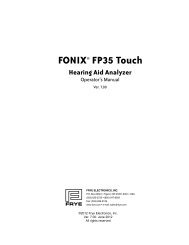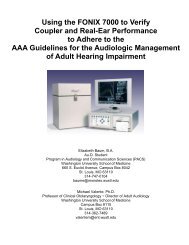FONIX® 8000 - Frye Electronics
FONIX® 8000 - Frye Electronics
FONIX® 8000 - Frye Electronics
You also want an ePaper? Increase the reach of your titles
YUMPU automatically turns print PDFs into web optimized ePapers that Google loves.
92 FONIX <strong>8000</strong> Hearing Aid Test System<br />
Technical details<br />
The digital processing delay measurement is taken by sending a short impulse<br />
from the sound chamber speaker to the hearing aid. The FONIX <strong>8000</strong> Test<br />
System microphone collects information from the hearing aid for 20 milliseconds<br />
from the time the impulse is delivered. This information is a series of<br />
numbers of varying amplitudes.<br />
The FONIX <strong>8000</strong> Test System finds the maximum peak amplitude of the resulting<br />
information. Since the impulse response of a hearing aid is not always<br />
simple, the analyzer also checks for any peaks occurring before this maximum<br />
peak. If a smaller peak exists, and it has an amplitude of at least 50% of the<br />
maximum peak, the time of the smaller peak will be considered the processing<br />
delay point. Otherwise, the time of the maximum peak will be considered<br />
the processing delay point. The <strong>8000</strong> Test System delay is subtracted from this<br />
delay point in order to form the actual aid processing delay time. (The <strong>8000</strong> Test<br />
System delay is determined during the sound chamber leveling process.)<br />
The data collected in the digital processing delay measurement is displayed in<br />
graphical format as amplitude vs. time. A dashed vertical line is placed at the<br />
calculated delay point. The numerical value is also displayed. A second dotted<br />
vertical line shows the <strong>8000</strong> system delay for reference.<br />
4.1.2 Signal Phase<br />
The signal phase measurement is a test of the “pushing” and “pulling” of the<br />
amplified sound of the hearing aid. Vibrations in the air create sound—these<br />
vibrations can be thought of as air pushing and pulling against the ear. If sound<br />
goes through a hearing aid, the hearing aid might cause a phase shift, turning a<br />
“push” of the sound wave into a “pull.” This isn’t necessarily a bad thing; there<br />
may be good reasons for a phase shift of the sound wave.<br />
The components of a custom hearing aid are usually wired by hand. The<br />
receiver is typically wired into the amplifier in such a way that it may or may<br />
not cause a phase shift of the signal. If care is not taken, it’s entirely possible to<br />
wire one hearing aid of a custom binaural set one way, and wire the other aid in<br />
the opposite way. This could cause one of the hearing aids to be “pulling” while<br />
the other aid is “pushing,” resulting in strange sound quality for the hearing aid<br />
wearer.<br />
We propose that it could be very important to check the signal phase of the<br />
hearing aids when fitting a client with a binaural set in order to ensure that the<br />
aids are working together as a team.<br />
Technical Details<br />
The signal phase measurement works by generating a 1 kHz cosine wave, turning<br />
it into a test signal and delivering it to the aid. The cosine wave signal is<br />
offset at the time of generation so that it starts at the baseline (the zero point).
















